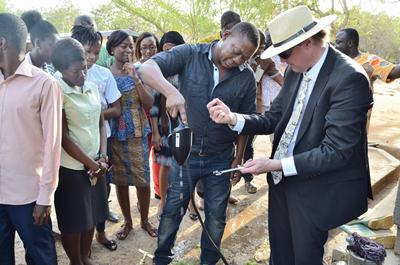Two inventions using just sound, air and water: StarStream cleans in hospitals and StarHealer cleans and heals wounds

Thanks to a recent NIHR grant*, a patented hard-surface cleaning device, which uses just cold water and electricity, will be trialled in 20 hospitals across the UK in Sterile Services Departments (SSDs). StarStream is one of many remarkable inventions capable of manipulating sound within water to produce different cleaning effects or transform materials. This suite of Star Products arise from research on the acoustics of bubbles begun by Professor Timothy Leighton in the 1980s, which he has now patented.
Whilst StarStream is designed to clean the hard surfaces of surgical instruments, the latest Star Product, StarHealer, is designed to clean the soft tissue of wounds, as well as heal them.
Professor Leighton and his StarHealer team (Dr David Voegeli, Health Sciences; Dr Tom Secker, Natural and Environmental Sciences; and Dr Christopher Harling, a PhD student of Professor Leighton’s) recently won a Royal Society LLLE Wolfson Foundation Award to further develop this next generation of ultrasonic wound therapeutics.

Next-generation ultrasonic wound therapeutics
Powerful enough to remove MRSA and antibiotic-resistant strains of infection by using just moderately clean water and electricity, StarHealer is more than a next-generation StarStream. Although both send sound through water to activate ultrasonic bubbles, StarHealer not only cleans wounds (reducing the risk of Sepsis) but also stimulates more rapid reformation of the skin layers, acting as a barrier to further infection.
When skin is damaged, keratinocytes from the undamaged skin are triggered into moving across the surface to begin the healing process of re-growth. Using ultrasonic bubbles, StarHealer activates a complex set of triggers, agitating the keratinocytes and epithelial stem cells to come to the wound edge far more quickly, and begin growing a protective layer of skin.
Professor Leighton says: “One way of explaining how StarHealer works is by analogy with modern sea mines, which are similarly complex devices to fibroblasts in skin – needing multi-triggers to activate.
“There’s really nothing like it in the world that can clean and heal at the same time, using just electricity and water. It’s my aim to be testing the StarHealer on patients in UK NHS hospitals within 18 months.”

A wide range of uses
StarHealer is suitable for a wide range of therapeutic uses such as in treating chronic wounds, which in turn would reduce the need for amputations, through to mothers and their new born babies in developing countries. Other scenarios include use by mountain rescuers, army medics and in field clinics.
Professor Leighton and a student, Mengyang Zhu, recently returned from rural Ghana where infection is the largest cause of death and babies have a six per cent chance of dying before they reach 28 days old. And with the rise of AntiMicrobial resistance (AMR), by 2050 many deaths worldwide from such infections will exceed those from cancer. “My ambition is to reduce the chances of Sepsis and decrease the terrible mortality rate of babies and their mothers in this environment. We’re looking to manufacture the StarHealer robustly enough so that it can be used by rural nurses carrying equipment on motorbikes.” says Professor Leighton.
Ambitious plans
This new innovation has come from a truly integrated approach from across the University involving engineers, health and biological sciences researchers. Professor Leighton’s plans are nothing short of ambitious, aiming to move StarHealer into manufacturing within three years.
*This NIHR grant typifies the cross-Faculty collaborations fostered by NAMRIP (the Network for AntiMicrobial Resistance and Infection Prevention), in this case bringing together researchers from Natural and Environmental Sciences (Professor Keevil, Dr Secker and Dr Herve) with Professor Leighton.